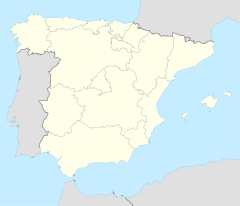Colegiata de Santa Maria la Mayor, Calatayud facts for kids
Quick facts for kids Collegiate church of Santa María |
|
|---|---|
|
Colegiata de Santa María
|
|
 |
|
| Religion | |
| Affiliation | Roman Catholic Church |
| Status | Church |
| Location | |
| Location | Calatayud (Zaragoza), Spain |
| UNESCO World Heritage Site | |
| Official name | Apse, cloister and tower of Colegiata de Santa María |
| Part of | Mudéjar Architecture of Aragon |
| Criteria | Cultural: (iv) |
| Inscription | 1986 (10th Session) |
| Extensions | 2001, 2016 |
| Official name: Colegiata de Santa María | |
| Type: | Non-movable |
| Criteria: | Monument |
| Designated: | 14 June 1884 |
| Reference #: | RI-51-0000042 |
The Collegiate church of Santa María la Mayor is a beautiful Roman Catholic church. It is located in Calatayud, a town in Aragon, Spain. This church shows a special mix of two building styles: Mudéjar and Gothic.
Mudéjar is a unique Spanish art style. It was created by Muslim craftsmen who stayed in Spain after the Christian Reconquista. They used their skills to build for Christian rulers.
Contents
History of the Church
Building the Church
The church was started in the 12th century. This happened after King Alfonso I el Batallador took Calatayud back from Muslim rule. The church was built right where the town's main mosque used to be.
Important Meetings
The Collegiate church of Santa María played an important role in history. It hosted some meetings of the Cortes de Calatayud. These were like important government meetings. This happened when King Pedro IV of Aragon was in charge.
Later, the town promised loyalty to Emperor Charles I here. They also swore loyalty to King Philip III of Spain in this church. In 1884, the church was named a Bien de Interés Cultural. This means it is a very important cultural site in Spain.
Art and Architecture
Original Design and Changes
From its first Mudéjar-Gothic design, the church still has its cloister, tower, and apse. The cloister is a covered walkway around a courtyard. The apse is the rounded part at the end of the church.
In the 16th century, a new main entrance was added. This entrance, called a portal, was carved from alabaster. Alabaster is a soft, white stone. The artists who carved it were Juan de Talavera and Esteban de Obray.
Recognized as a Monument
In 1884, the church was officially called a Monumento Nacional. This means it is a national monument. A gate was put around the main entrance to protect it.
In 2001, something even more special happened. UNESCO recognized the church as a World Heritage Site. It is part of the larger "Mudéjar Architecture of Aragon" site. This means it is important for everyone in the world to protect.
The Tower of Santa María
Tower Features
The church has a tall tower called the Torre de Santa María. It is about 70 meters (230 feet) high. The tower is made of brick and has eight sides, making it an octagon.
The decorations on the tower become more detailed as you look higher up. This is a common feature of these types of towers. Building the tower took many centuries to complete.
Inside the Tower
At the bottom, the tower's walls are very thick, about 1.5 meters (5 feet). Inside, there is a spiral staircase. It winds its way up between an inner and an outer wall. The pointy top part of the tower, called the spire, was added later. It was built in the mid-to-late 18th century.
See also
 In Spanish: Colegiata de Santa María la Mayor (Calatayud) para niños
In Spanish: Colegiata de Santa María la Mayor (Calatayud) para niños


